

Home Site Search Contact Us Subscribe
|
|
|
|
The Multi Purpose Platform (MPP) Bunker: Portable, Watertight, Bombproof - and then some
Though not-yet priced for Home Depot shelves, this clever pod has multiple applications. by Kristen Richards November 21, 2002 A staggering amount of items find their way into our e-mailbox – from the mundane to the amazing. One of the more unusual items arrived earlier this week from Jorge Villa, founder and president of a Miami-based company called U.S. Bunkers. His note opened with: “This is to bring you up to date in the latest invention in structures capable of withstanding hurricanes, tornadoes, and even military and terrorist attacks.” With things being as they are in the world today, finding the words “tornado” and “terrorist” in the same sentence did not seem far-fetched, and we decided to explore further. Villa, a University of Miami graduate in Mechanical Engineering with majors in Civil and Industrial Engineering, has developed what he calls the Multi Purpose Platform (MPP) Bunker. He introduced the latest model, The Guardian, at the Association of the United States Army Show in Washington D.C. in October. It was set up as a working security and surveillance unit (complete with camouflage exterior) that, apparently, was a real showstopper. The form of the bunkers harkens back to John Lautner’s Chemosphere (Flying Saucer) House in Los Angeles (or kicky space pods from sci-fi movies of an earlier era). But there is a very contemporary logic to the form and construction. According to Villa, the watertight and bulletproof bunkers “have been carefully designed to deflect debris and projectiles from any and all sides.” The bunkers are made of Fiberglas, steel, reinforced concrete, rebar, and U.S.
Bunker’s own mix of polymer fibers. The monolithic structures are 12 inches
thick at the center strength ring, manufactured with no seams or joints, and
weigh in at 13-15 tons (even so, the company touts them as being portable). The bunkers
come equipped with an induced forced air system moved by a dual turbine system
that changes the inside air every 60 seconds (bio-chemical filters and heat/air
conditioning are optional, as are cameras, video, and surveillance equipment).
They can be made totally self-supporting by mounting a generator or solar
panels and a battery bank along with along with water and fuel tanks on the
four steel supports. A portable potty,
powerful ventilation system, lighting 12 & 110, battery bank, first aid
kit, TV, VHS, 2 cameras (exterior), and an electric door are considered
standard equipment. Beyond
the obvious military/government applications, Villa sees the potential for the
bunkers to be deployed either before or immediately after natural disasters
strike as field hospitals (the
Fiberglas interior can be sterilized in minutes), distribution centers,
communications hubs, and any other emergency needs. They can also be used as
arctic and underwater research/exploration modules. Interior
configurations include office set-ups and dormitory-style sleeping quarters. They could be fun backyard playhouses (or even guest bungalows), but at $48,000 a unit, they won’t be standard suburban fare for a while. “The price is a bit high right now,” Villa says, “but like everything else – with time and fabrication innovations – the price will come down.” By the same token, $48,000 doesn’t seem like such a high ticket for a structure that could serve as full-time emergency medical centers and even housing in underdeveloped regions around the world. The U.S. Bunker Web site focuses primarily on military/government uses, but I’d like to think there is potential for much wider (and humanitarian) applications. Specs: Interior
diameter/width: 9 feet Interior
height: 6 feet 4 inches Interior
space: 240 cubic feet Exterior
diameter/width: 11 feet Exterior
height: 7 feet 6 inches |
(click on pictures to enlarge) 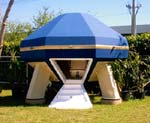 (U.S. Bunkers) Bunker in blue: the exterior can be anything - colors, camouflage, logos, etc. (U.S. Bunkers) Watertight and thermal for underwater, desert, and even arctic environments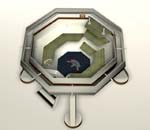 (U.S. Bunkers) Seats six - with headroom to stand (U.S. Bunkers) Section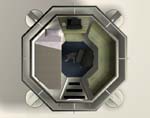 (U.S. Bunkers) Office configuration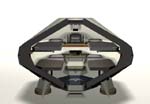 (U.S. Bunkers) Dormitory configuration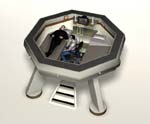 (U.S. Bunkers) Medical configuration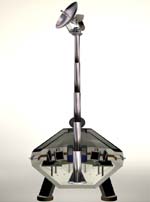 (U.S. Bunkers) Communications hub |
© 2002 ArchNewsNow.com